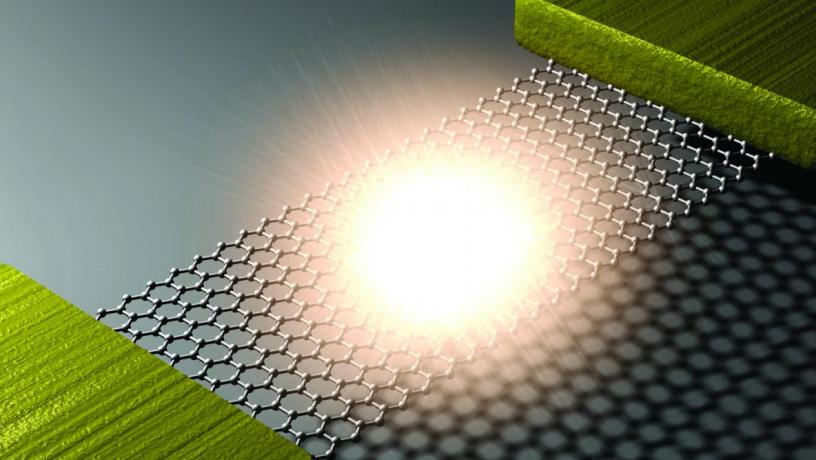Electrons in Graphene Behave Like Light, Only Better
For the first time, researchers have directly observed electrons behaving like light rays in graphene, an atom-thin form of carbon. The discovery, first theorized a decade ago, could enable new experimental probes and low-power electronics with electron switches based on the principles of optics rather than electronics.

Graphene is an atom-thin form of carbon. (Illustrations courtesy of Nicoletta Barolini and Young Duck Kim)
“The ability to manipulate electrons in a conducting material like light rays opens up entirely new ways of thinking about electronics,” said Cory Dean, an assistant professor of physics who leads the team along with James Hone, Wang Fong-Jen Professor of Mechanical Engineering, and Avik Ghosh of the University of Virginia.
“For example,” Dean said, “the switches that make up computer chips operate by turning the entire device on or off, and this consumes significant power. Using lensing to steer an electron ‘beam’ between electrodes could be dramatically more efficient, solving one of the critical bottlenecks to achieving faster and more energy-efficient electronics.”
Electron lensing could also enable onchip versions of an electron microscope, with the ability to perform atomic-scale imaging and diagnostics. “Other components inspired by optics, such as beam splitters and interferometers, could additionally enable new studies of the quantum nature of electrons in the solid state,” Dean said.
Light changes direction—or refracts— when passing from one material to another, a process that allows us to use lenses and prisms to focus and steer light. A quantity known as the index of refraction determines the degree of bending at the boundary and is positive for conventional materials, such as glass. Through clever engineering, however, it is also possible to create optical “metamaterials” with a negative index, in which the angle of refraction is also negative.
“This can have unusual and dramatic consequences,” Hone noted. “Optical metamaterials are enabling exotic and important new technologies such as super lenses, which can focus beyond the diffraction limit, and optical cloaks, which make objects invisible by bending light around them.”
Bright Visible Light Emission in Graphene
Electrons traveling through very pure conductors can travel in straight lines like light rays, enabling optics-like phenomena to emerge. In materials, electrons refract when they pass from one region to another that has a different density. Moreover, current carriers in materials can either behave as if they are negatively charged or positively charged, depending on which band of the atomic structure they inhabit. In fact, boundaries between positive and negative conductors, known as p-n junctions, form the building blocks of electrical devices such as diodes and transistors.
The development of two-dimensional conducting layers in high-purity semiconductors in the 1980s and 1990s allowed researchers to first demonstrate electron optics, including the effects of both refraction and lensing. However, in these materials, electrons travel without scattering only at very low temperatures, limiting technological applications. The researchers’ use of graphene, a two-dimensional form of carbon with unsurpassed performance at room temperature and no energy gap, overcame the limitations, allowing them to demonstrate negative refraction for the first time.
The possibility of negative refraction in graphene was first proposed in 2007 by theorists at Columbia University and the University of Lancaster. However, observation of this effect requires extremely clean devices, such that the electrons can travel ballistically, without scattering, over long distances. Over the past decade, a multidisciplinary team at Columbia—including Dean and Hone, along with Kenneth Shepard, Lau Family Professor of Electrical Engineering and professor of biomedical engineering, and Abhay Pasupathy, associate professor of physics—has worked to develop new techniques to construct extremely clean graphene devices.
